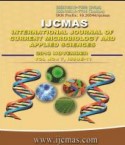


 National Academy of Agricultural Sciences (NAAS)
National Academy of Agricultural Sciences (NAAS)

|
PRINT ISSN : 2319-7692
Online ISSN : 2319-7706 Issues : 12 per year Publisher : Excellent Publishers Email : editorijcmas@gmail.com / submit@ijcmas.com Editor-in-chief: Dr.M.Prakash Index Copernicus ICV 2018: 95.39 NAAS RATING 2020: 5.38 |
Traditional medicines of plant origin have become the alternative remedies to treat human as well as animal ailments. People rely on medicinal plants due to their faith in traditional healing process. One of traditional medicinal plant rich in nutrients is garden cress (Lepidium sativum L.). Despite ubiquitous occurrence, people know very little about this nature’s creation of a treasure trove of nutrients. The present study was undertaken to investigate the proximate, mineral and chemical composition of different parts viz. seeds, aerial parts and roots of garden cress (Lepidium sativum L.) collected from two different locations i.e. Hisar and Solan. Results revealed that all parts of garden cress were found to have good proximate composition. On the basis of calorific value, all parts of garden cress collected from both locations were found to be very rich sources of energy. Seeds, aerial parts and roots of garden cress contained significant amount of minerals viz. Fe, Cu, Zn and Mn. Different parts of garden cress also contained ascorbic acid, starch, tannins, total sugars, reducing sugars and non-reducing sugars in varying amounts. Hence, this treasure trove plant could have the potential in various pharmaceutical formulations.
 |
 |
 |
 |
 |